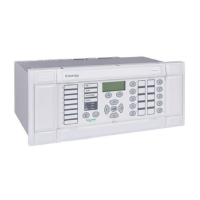P54x/EN AP/La4 Application Notes
(AP) 6-68
MiCOM P543, P544, P545 & P546
AP
3.6.2 Intermicom
64
application example general advice
MiCOM relays have standard, pre-configured aided scheme logic internal to each relay.
Therefore, it is not necessary to draw the zone logic for Permissive Underreach, Permissive
Overreach or Blocking schemes within the PSL. To gain the benefit of selecting a proven
and tested scheme, the standard “Aided” scheme logic should be used.
When InterMiCOM
64
is being used as the transmission medium for the aided channel
signal(s), all that is required is to create one-to-one mapping between the Aided scheme
logic, and the InterMiCOM
64
(IM64) signals to be used. The PSL editor is used to perform
the simple mapping required.
In order to configure the signal SEND logic:
Route the required Aided send DDB signal to the IM64 Output to be used.
In order to configure the signal RECEIVE logic:
Route the required IM64 Input signal to the Aided scheme Rx DDB input.
3.6.3 Three-ended applications
The
example in the section 3.6.2 illustrates a three terminal application, i
n this case in a
BLOCKING or PUR scheme mode. Note that this breaks with the rule of the one-to-one
mapping as described in section 3.6.2. In three terminal schemes, the input to the Aided
scheme i
s some kind of logic combination of the signals received from the two remote ends:
BLOCKING schemes are recommended to take a logical OR of the incoming IM64
signals, before being mapped to Aided scheme Rx. This is to ensure that if the fault is
declared as external at any line end, Zone 2 accelerated tripping at the local end is
blocked.
PERMISSIVE UNDERREACH schemes are recommended to take a logical OR of the
incoming IM64 signals, before being mapped to Aided scheme Rx. Thus, if the fault is
declared as internal at any remote line end, Zone 2 accelerated tripping at the local end
is allowed. As Zone 1 is an underreaching element, it can only key the channel for an
internal fault, so there is no need for AND logic.
PERMISSIVE OVERREACH schemes are recommended to take a logical AND of the
incoming IM64 signals, before being mapped to Aided scheme Rx. This is to ensure that
the fault must be seen as forward from both remote ends before Zone 2 accelerated
tripping at the local end is allowed. As Zone 2 keys the channel, confirmation of a
forward decision at all three line ends must be confirmed before aided scheme tripping is
permitted.
In all three terminal schemes, the send logic is a one-to-many mapping. The Aided send is
mapped to the IM64 signals which transmit to both remote ends. The connection to Ch1
(channel 1), and Ch2 (channel 2) ensures communication to the two remote ends. In case of
channel failure between any two relays, the ‘Aided 1 COS/LGS’ signal will become high in
the relay that is not receiving and activate the FallBackMode. Therefore, to preserve the
stability in 3-ended blocking scheme, the corresponding ‘IM_X DefaultValue’ in the setting
file must be set high. It should be noted that in the PUR and POR schemes such a
precaution is not necessary since the aided signal can not be sent via broken
communications.

